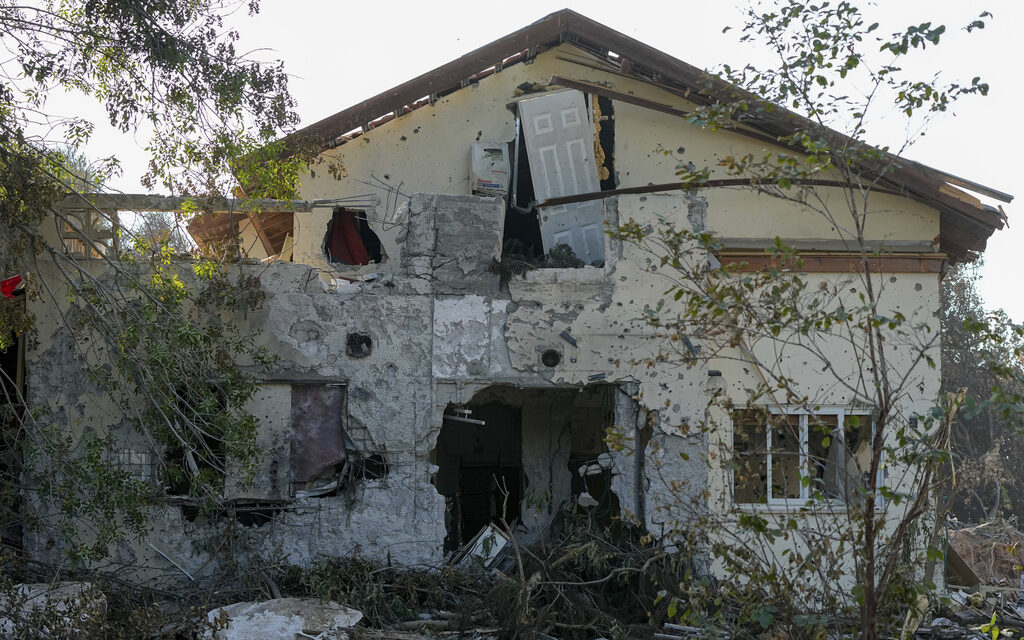By Wafaa Shurafa and Joseph Krauss
The Associated Press
DEIR AL-BALAH, Gaza Strip (AP) — Palestinians struggled Oct. 14 to flee from areas of Gaza targeted by the Israeli military while grappling with a growing water and medical supply shortage ahead of an expected land offensive a week after Hamas’ bloody, wide-ranging attack into Israel.

Israel renewed calls on social media and in leaflets dropped from the air for Gaza residents to move south, while Hamas urged people to stay in their homes. The U.N. and aid groups have said such a rapid exodus along with Israel’s siege of the territory would cause untold human suffering.
The evacuation directive covers an area of 1.1 million residents, or about half the territory’s population. The Israeli military said “hundreds of thousands” of Palestinians had heeded the warning and headed south. It gave Palestinians a six-hour window that ended Oct. 14 to travel safely within Gaza along two main routes.
A week after Hamas’ attack, Israel was still working to assess the casualties. With special rabbinic approval, workers at a military base in central Israel continued the grueling task of identifying the bodies of the Israelis and foreign nationals who were killed, mostly civilians. Work is normally halted on Saturday, the Jewish Sabbath.
Prime Minister Benjamin Netanyahu visited Beeri and Kfar Aza on Oct. 14, two southern border communities where Hamas militants killed dozens of Israelis in their initial attack, to meet with soldiers and tour the ruins of homes where the killings happened. Netanyahu has faced criticism that his government has not done enough to meet with relatives of the slain.
In a nationally broadcast address the night of Oct. 14, Israel’s chief military spokesman, Rear Adm. Daniel Hagari, accused Hamas of trying to use civilians as human shields and issued a new appeal to Gaza residents to move south.
“We are going to attack Gaza City very broadly soon,” he said, without giving a timetable for the attack against the 40-kilometer (25-mile) long territory.
The military said it was preparing a coordinated offensive in Gaza using air, ground and naval forces.
Hamas remained defiant. In a televised speech Oct. 14, Ismail Haniyeh, a top Hamas official, said that “all the massacres” will not break the Palestinian people.
Meanwhile, attacks continued, with Hamas launching rockets into Israel and Israel carrying out strikes in Gaza.
An Israeli airstrike near the Jabaliya refugee camp in northern Gaza killed at least 27 people and wounded another 80, Gaza health authorities said. Most of the victims were women and children, the authorities said. Doctors from Kamal Edwan Hospital shared chaotic footage of charred and disfigured bodies.

It was not clear how many Palestinians remained in north Gaza by Oct. 14, said Juliette Touma, a spokesperson for the U.N. agency for Palestinian refugees. An estimated 1 million people have been displaced in Gaza in one week, she said.
An estimated 35,000 displaced civilians have crammed into the grounds of Gaza City’s main hospital, sitting under trees in the empty grounds, as well as inside the building’s lobby and corridors, hoping they will be protected from the fighting, medical officials said.
“People think this is the only safe space after their homes were destroyed and they were forced to flee,” said Dr. Medhat Abbas, a Health Ministry official. “Gaza City is a frightening scene of devastation.”
Basic necessities like food, fuel and drinking water also were running low because of a complete Israeli siege.
Water has stopped coming out of taps across the territory. Amal Abu Yahia, a 25-year-old pregnant mother in the Jabaliya refugee camp, said she waited anxiously for the few minutes each day or every other day when contaminated water trickles from the pipes in her basement. She rations it, prioritizing her 5-year-old son and 3-year-old daughter. She said she is drinking so little herself, she only urinates every other day.
Near the coast, the only tap water is contaminated with Mediterranean Sea water because of the lack of sanitation facilities. Mohammed Ibrahim, 28, said his neighbors in Gaza City have taken to drinking the salt water.
“Gaza has been out of water for almost three days, we have no power, no electricity,” said Inas Hamdan, a spokesperson for the U.N. agency for Palestinian refugees. “If there is no humanitarian corridor, consequences will be catastrophic.”
The Israeli military’s evacuation order demands the territory’s entire population cram into the southern half of Gaza as Israel continues strikes across the territory, including in the south.
Rami Swailem said he and at least five families in his building decided to stay put in his apartment near Gaza City. “We are rooted in our lands,” he said. “We prefer to die in dignity and face our destiny.”
Others were looking desperately for ways to evacuate. “We need a number for drivers from Gaza to the south, it is necessary #help,” read a post on social media. “We need a bus number, office, or any means of transport,” read another.
The U.N. refugee agency for Palestinians expressed concern for those who could not leave, “particularly pregnant women, children, older persons and persons with disabilities,” saying they must be protected. The agency also called for Israel to not target civilians, hospitals, schools, clinics and U.N. locations.
Al-Shifa hospital was receiving hundreds of wounded every hour and had used up 95 percednt of its medical supplies, hospital director Mohammad Abu Selim said. Water is scarce and the fuel powering its generators is dwindling.
“The situation inside the hospital is miserable in every sense of the word,” he said. “The operating rooms don’t stop.”
Patients and personnel from the Al Awda Hospital in Gaza’s far north spent part of the night in the street “with bombs landing in close proximity,” the medical aid group Doctors Without Borders said.
An Israeli military spokesperson, Jonathan Conricus, said the evacuation was aimed at keeping civilians safe and preventing Hamas from using them as human shields. He urged people in the targeted areas to leave immediately and to return “only when we tell them that it is safe to do so.”
“The Palestinian civilians in Gaza are not our enemies. We don’t assess them as such, and we don’t target them as such,” Conricus said. “We are trying to do the right thing.”
Thousands of people crammed into U.N.-run schools across Gaza.
“I came here with my children. We slept on the ground. We don’t have a mattress, or clothes,” said Howeida al-Zaaneen, 63, who is from the northern town of Beit Hanoun. “I want to go back to my home, even if it is destroyed.”
The Israeli military said its troops conducted temporary raids into Gaza on Oct. 13 to battle militants and hunted for traces of some 150 people — including men, women and children — who were abducted during Hamas’ shocking Oct. 7 assault on southern Israel.
The Gaza Health Ministry said Oct. 14 that over 2,200 people have been killed in the territory, including 724 children and 458 women. The Hamas communications office said that Israel has “completely demolished” over 7,000 housing units so far.
Hamas’ surprise attack killed more than 1,300 people on the Israeli side, most of them civilians, and roughly 1,500 Hamas militants died during the fighting, the Israeli government said.
Egyptian officials said the country’s Rafah border crossing with Gaza would open Oct. 14 for the first time in days to allow foreigners out. But by that night there had been no movement. There were believed to be some 1,500 people in Gaza holding Western passports and additional people with passports from other parts of the world.
Israel’s raids into Gaza on Oct. 13 were the first acknowledgment that Israeli troops had entered the territory since the military began its round-the-clock bombardment in retaliation for the Hamas massacre. Palestinian militants have fired more than 5,500 rockets into Israel since the fighting erupted, the Israeli military said.
Israel has called up some 360,000 military reserves and massed troops and tanks along the border with Gaza. A ground assault in densely populated Gaza would likely bring even higher casualties on both sides in brutal house-to-house fighting.
U.S. Secretary of State Antony Blinken met with Saudi Foreign Minister Faisal bin Farhan in Riyadh on Oct. 14, and both called for Israel to protect civilians in Gaza.
“As Israel pursues its legitimate right to defend its people and to try to ensure that this never happens again, it is vitally important that all of us look out for civilians,” Blinken said.
Hamas said Israel’s airstrikes killed 22 hostages, including foreigners. It did not provide their nationalities. The Israeli military denied the claim. Hamas and other Palestinian militants hope to trade the hostages for thousands of Palestinians held in Israeli prisons.
In the occupied West Bank, the Palestinian Health Ministry says 53 Palestinians have been killed since the start of the war, including 16 on Oct. 13. The U.N. says attacks by Israeli settlers have surged there since the Hamas assault.
___
Krauss reported from Jerusalem. Associated Press writers Isabel DeBre and Julia Frankel in Jerusalem, Samya Kullab in Baghdad, Samy Magdy in Cairo, Ashraf Sweilam in El-Arish, Egypt, Kareem Chehayeb in Beirut and Matthew Lee in Riyadh contributed to this report.
The post Palestinians in Gaza struggle to follow Israeli evacuation order and face dire water shortage appeared first on AFRO American Newspapers .











